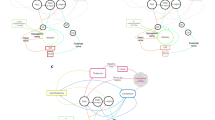Abstract
Studies on cats anesthetized with a mixture of chloralose and Nembutal addressed the effects of high-frequency stimulation (100 impulses/sec) of the central nucleus of the amygdala on bioelectrical activity in two postganglionic sympathetic nerves—the inferior cardiac nerve and the vertebral branch of the stellate ganglion, which innervate the coronary vessels and the vessels of the anterior thorax respectively. The central nucleus of the amygdala was found to have differential, selective effects, in most experiments producing increases in the amplitude of integrated activity in the inferior cardiac nerve and decreases in the amplitude of biopotentials in the vertebral nerve. In a few experiments, a second type of modulation of the activities of these two postganglionic nerves was seen, with selective inhibition of activity in the inferior cardiac nerve and an accompanying increase in activity in the vertebral nerve. Stimulation of the central nucleus of the amygdala induced significant increases in systemic arterial blood pressure. The role of the central nucleus of the amygdala in the development of experimental neurogenic hypertension was studied in a series of chronic experiments on rats; these established that rats subjected to bilateral electrolytic lesioning of the central nucleus of the amygdala prevented the development of neurogenic hypertension induced by daily imposition of stress for four weeks for induction of operant aversive conditioned reflexes, which was not the case in control rats. The role of the central nucleus of the amygdala in the regulation of vascular tone is discussed.
Similar content being viewed by others
References
O. G. Baklavadzhyan, “Neuronal mechanisms of the hypothalamic control of sympathetic nervous system activity,”Fiziol. Zh. (Kiev),24, No. 5, 602–608 (1978).
O. G. Baklavadzhyan, “Autonomic mechanisms of the hypothalamus,” in:Autonomic Nervous System Physiology [in Russian], Nauka, Leningrad (1981), pp. 398–474.
O. G. Baklavadzhyan and O. K. Sar'yan, “Hypothalamic mechanisms of regulation of the circulation in the coronary and brachial arterial systems,”Fiziol. Zh. SSSR,64, No. 7, 954–964 (1978).
O. G. Baklavadzhyan, A. G. Darbinyan, I. Kh. Taturyan, and A. V. Khachatryan, “Studies of the role of the paraventricular nucleus of the hypothalamus in the development of chronic neurogenic hypertension and the formation of a self-stimulation reaction,”Ros. Fiziol. Zh. im. I. M. Sechenova,80, No. 2, 16–22 (1994).
A. V. Val'dman,The Neuropharmacology of the Central Regulation of Vascular Tone [in Russian], Nauka, Lenningrad (1976).
D. B. Adams, G. Baccelli, G. Mancia, and A. Zanchetti, “Relation of cardiovascular changes in fighting to emotion and exercise,”J. Physiol. (London),212, No. 2, 321–335 (1971).
P. Bolme, S. H. Ngai, and S. Rosells, “Influence of vasoconstrictor nerve activity on the cholinergic vasodilator response in skeletal muscle in the dog,”Acta Physiol. Scand. 7, No. 4, 323–333 (1967).
B. Folkov and E. H. Rubinstein, “Behavioral and autonomic patterns evoked by stimulation of the lateral hypothalamic area in the cat,”Acta Physiol. Scand.,65, No. 4, 292–299 (1965).
T. Galeno and M. J. Brody, “Hemodynamic responses to amygdaloid stimulation in spontaneously hypertensive rats,”Amer. J. Physiol.,245, No. 2, 281–286 (1983).
A. K. Goodchild, R. A. Damney, and R. J. Bandler, “A method for evoking physiological responses by stimulation of cell bodies but not axons of passage within localized region of the central nervous system,”J. Neurosci. Meth.,6, 351–363 (1982).
K. Hecht, K. Treptow, N. Poppei, and T. Hecht, “Ein Modell für die Entwickung Hyperton ausgelenkter Blutdruck dysregulationen durch fehlgesteurtes Lemen,”Acta Biol. Med. Germ.,27, No. 2, 869–883 (1971).
D. A. Hopkins and G. Holstege, “Amygdaloid projections to the mesencephalon, pons, and medulla oblongata in the rat,”Exp. Brain Res.,32, No. 4, 529–547 (1978).
Y. Iwata, K. Chide, and Y. E. La Doux, “Cardiovascular responses elicited by stimulation of neurons in the central amygdaloid nucleus in awake but not anesthetized rats resemble conditioned emotional responses,”Brain Res.,418, No. 1, 183–188 (1987).
J. E. La Doux, A. Sakaguchi, and D. J. Reis, “Subcortical efferent projections of the medial geniculate nucleus mediate emotional responses conditioned to acoustic stimuli,”J. Neurosci.,6, 683–698 (1986).
D. Van der Kooy, L. J. Koda, and J. F. Meginty, “The organization of projections from the cortex, amygdala and hypothalamus to the nucleus of the solitary tract in rat,”J. Comp. Neurol. 229, No. 1, 1–24 (1984).
Author information
Authors and Affiliations
Additional information
Translated from Rossiiskii Fiziologischeskii Zhurnal imeni I. M. Sechenova, Vol 84, No. 12, pp. 1370–1376, December, 1998.
Rights and permissions
About this article
Cite this article
Baklavadzhyan, O.G., Pogosyan, N.L., Arshakyan, A.V. et al. Studies of the role of the central nucleus of the amygdala in controlling cardiovascular functions. Neurosci Behav Physiol 30, 231–236 (2000). https://doi.org/10.1007/BF02463163
Received:
Issue Date:
DOI: https://doi.org/10.1007/BF02463163




